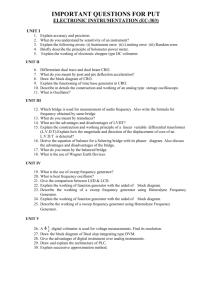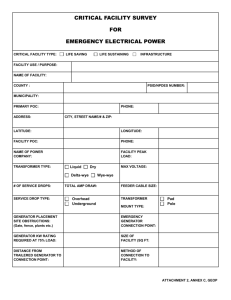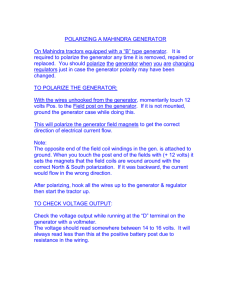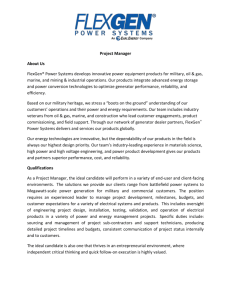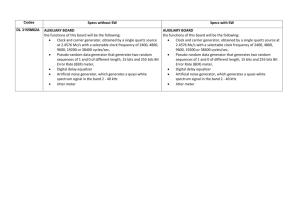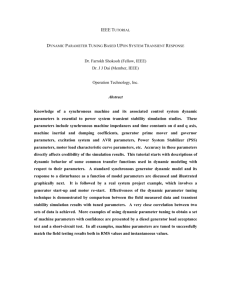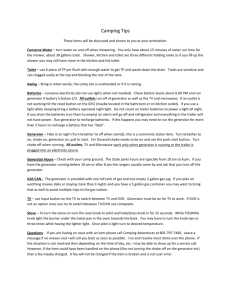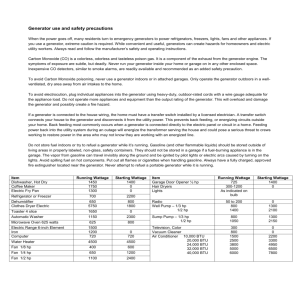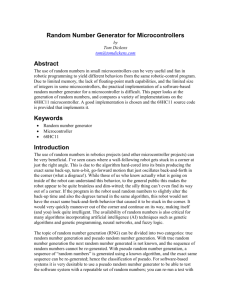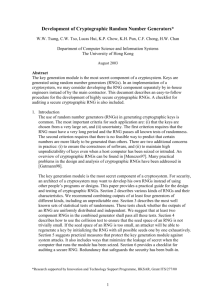example - Robothon
advertisement
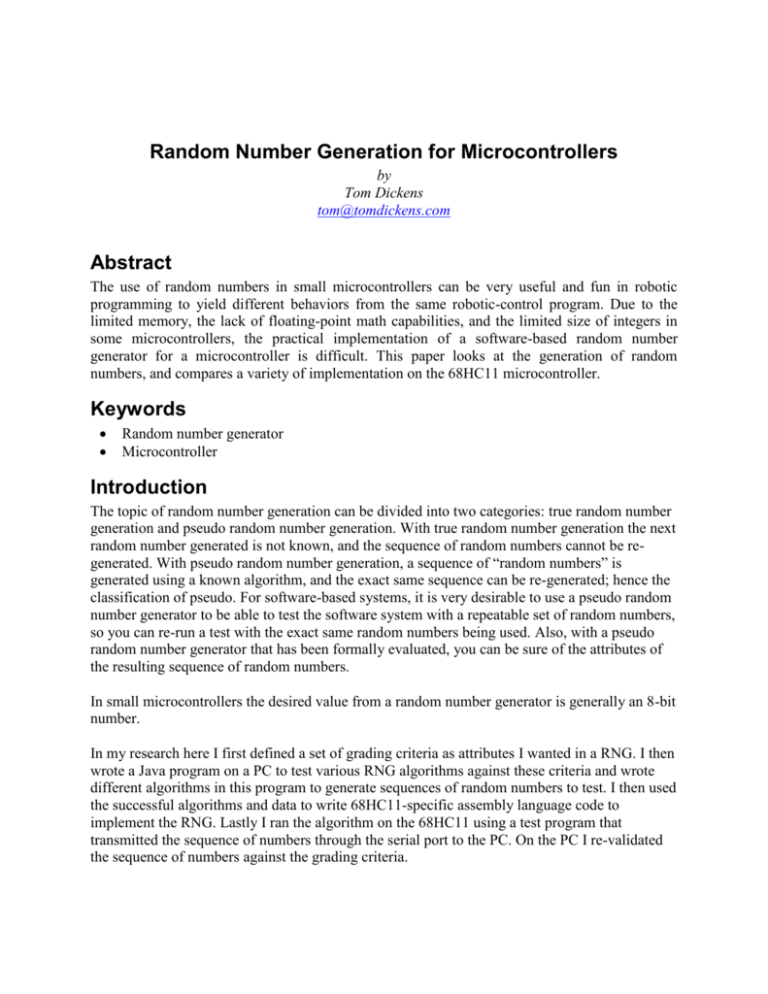
Random Number Generation for Microcontrollers
by
Tom Dickens
tom@tomdickens.com
Abstract
The use of random numbers in small microcontrollers can be very useful and fun in robotic
programming to yield different behaviors from the same robotic-control program. Due to the
limited memory, the lack of floating-point math capabilities, and the limited size of integers in
some microcontrollers, the practical implementation of a software-based random number
generator for a microcontroller is difficult. This paper looks at the generation of random
numbers, and compares a variety of implementation on the 68HC11 microcontroller.
Keywords
Random number generator
Microcontroller
Introduction
The topic of random number generation can be divided into two categories: true random number
generation and pseudo random number generation. With true random number generation the next
random number generated is not known, and the sequence of random numbers cannot be regenerated. With pseudo random number generation, a sequence of “random numbers” is
generated using a known algorithm, and the exact same sequence can be re-generated; hence the
classification of pseudo. For software-based systems, it is very desirable to use a pseudo random
number generator to be able to test the software system with a repeatable set of random numbers,
so you can re-run a test with the exact same random numbers being used. Also, with a pseudo
random number generator that has been formally evaluated, you can be sure of the attributes of
the resulting sequence of random numbers.
In small microcontrollers the desired value from a random number generator is generally an 8-bit
number.
In my research here I first defined a set of grading criteria as attributes I wanted in a RNG. I then
wrote a Java program on a PC to test various RNG algorithms against these criteria and wrote
different algorithms in this program to generate sequences of random numbers to test. I then used
the successful algorithms and data to write 68HC11-specific assembly language code to
implement the RNG. Lastly I ran the algorithm on the 68HC11 using a test program that
transmitted the sequence of numbers through the serial port to the PC. On the PC I re-validated
the sequence of numbers against the grading criteria.
Hardware Methods
A true random number generator can be implemented in hardware using a white-noise[1] source.
In [2] and [3] a hardware circuit is detailed which is used to generate random numbers using a
pair of transistors. In [4] another hardware-based random number generator is discussed. While
quite useful in many robotic applications, a hardware-based random number generator is out of
the scope of the focus of this paper.
Requirements of a “Good” Random Number Generator
Two famous quotes on random numbers helps us to set the stage for the following discussion:
“Anyone who considers arithmetical methods of producing random digits is, of
course, in a state of sin.” John von Neumann (1903-1957).
“The generation of random numbers is too important to be left to chance.” Robert
R. Coveyou, Oak Ridge National Laboratory in Tennessee (Found in Ivars
Peterson, 'The Jungles of Randomness' pp 178).
In the “art” of generating random numbers you must determine the attributes you want in a
random number generator, and then test candidate random number generators against this
grading criteria. It is difficult to define a set of attributes that are simple to define, easily testable,
and complete enough to avoid sequences of numbers that follow a simple pattern, such as a
simple sequence (0, 1, 2, 3, 4, 5…) or an increment-by-N sequence (0, 21, 42, 63, 84…). For my
purposes with the 68HC11 microcontroller here is my list of needed attributes I used in testing
random number generators:
Table 1. Testable attributes for a good random number sequence.
Attribute
Number range
Number range
average
Cycle length
*
Parameters
Numbers from 0 to 255 are
generated.
The average of this number range is
127.5.
The length of the pseudo random
sequence shall be 256 numbers for
a small cycle, and at 16,384 (214),
32,768 (215), or 65,536 (216).
Rational
An 8-bit processor typically
works with 8-bit integers.*
Used in subsequent
attributes.
A 256-value cycle RNG may
be easy and small, and may
work well for many
applications. A 16K to 64K
cycle RNG would be more
general and better for many
applications.
A 16-bit number can be generated using two successive 8-bit values. We could add an attribute to consider the
goodness of a sequence of 16-bit values generated this way, but I decided against this.
Number coverage
All numbers in the range will be
included the same number of times
in the cycle. For example, for a
cycle length of 16,384, all numbers
0 through 255 will occur 64 times.
Large window
average
The average of 128 sequential
values in all selections from the
cycle will vary from the average by
at most 10% (i.e. 115 to 140).
The average of 128 sequential
values in at least 1 selection will
vary from the average by at least
5% above and by another selection
by at least 5% below (i.e. 121 to
134).
The average of 32 sequential values
in all selections from the cycle will
vary from the average by at most
25% (i.e. 95 to 159).
The average of 32 sequential values
in at least 1 selection will vary
from the average by at least 15%
above and by another selection by
at least 15% below (i.e. 108 to
147).
The average of 8 sequential values
in all selections from the cycle will
vary from the average by at most
50% (i.e. 64 to 191).
The average of 8 sequential values
in at least 1 selection will vary
from the average by at least 35%
above and by another selection by
at least 35% below (i.e. 83 to 172).
A specific value may or may not be
repeated in the cycle.
Large window
average
Medium window
average
Medium window
average
Small window
average
Small window
average
Repeated values
Repeated sequence
Value-to-value
delta
There is not any sequence of 4 or
more numbers that is repeated in
the cycle.
A sequence made from the
differences in the sequence values
will meet the same window average
and repeated criteria.
Through the cycle I want all
numbers to occur an equal
number of times so the
average of the cycle is the
average of the range, and to
ensure all values can be
encountered.
To make sure that any
sequence of this size will
cover a good range of values.
To make sure the window
averages are not all the same.
To make sure that any
sequence of this size will
cover a good range of values.
To make sure the window
averages are not all the same.
To make sure that any
sequence of this size will
cover a good range of values.
To make sure the window
averages are not all the same.
I want to discuss this, but to
not specify a requirement or
test for this.
3 or more repeated numbers
may be useful/interesting, but
I don’t want more than 3.
To make sure there are no
patterns in the deltas.
Operations allowed The operations used to implement
the random number generator are
8-bit add, subtract, shift, and, or,
exor, and 8-bit to 16-bit multiply.
Size of code
The size of the code to implement
the algorithm is to be as small as
possible, at most 200 bytes long.
Required RAM
The number of bytes of RAM
required to be dedicated to the
RNG should be as few as possible
and at most 8 bytes.
These are the commonly
offered microcontroller
operations, and are found in
the 68HC11.
Smaller is better with the
limited program space
available in microcontrollers.
Smaller is better with the
limited program space
available in microcontrollers.
Approaches
I investigated two different approaches to implementing a simple random number generator for
the 68HC11; a table-based method and an equation-based method.
Table-based method
For a table of 256 values, there are 256!, or 8.578e+506, possible ways to order the table. The
table-based approach uses a table of 128 values, and uses an algorithm to traverse the table in a
number of ways to generate a random number cycle 16,384 numbers in length. I used a table of
128 values and generated the other 128 values in the set of {0 – 255} by EXORing the first 128
values with $FF. Ax acceptable set of 128 values for this table include the criteria that EXORing
these 128 values will generate the remaining 128 values in the set. This gave me an effective
table of 256 values using only 128 bytes plus a small number of bytes for the implementation
logic. I then traverse this set of 256 values in 64 different ways to generate a sequence of 16,384
values. Once the driving logic of traversing the table was developed, a good set of table values
was determined using a program to try different sets of values* and testing the resulting table
against the specified grading criteria. I wrote a Java program to do this.
Equation-based method
An equation-based method uses a seed value, and for each random number this seed value is
used in an equation to generate a new seed value and also the random number. In the case of our
8-bit random number generator we want the seed value to be larger than the 8-bit number
returned since an 8-bit seed value will allow at most a cycle of 256 values. A classic equation for
generating random numbers[5] is:
unsigned long idum ;
...
idum = 1664525L * idum + 1013904223L ;
*
I used the random number generator in Java to populate the table, checking for the EXOR criteria, then testing the
resulting table against all of the grading criteria. Running this code found many acceptable solutions for the table
data; I choose one for my implementation.
More Stuff
This is a work in progress and I’m not done with it yet. I’m currently researching the best short
algorithm for the 68HC11. I will include the code that I decide is the best, along with more
graphs showing the topology of the random number sequence. This should fill up about 10 more
pages in the paper…
Conclusion
About The Author
Tom Dickens is an engineer and Associate Technical Fellow at The Boeing Company,
specializing in the design and implementation of hardware and software systems. He also teaches
evenings in the Seattle area at Boeing, the University of Washington, the University of Phoenix
(Washington campus), and Henry Cogswell College. Tom has been an active member of the
Seattle Robotics Society for about 15 years, has been the editor of the SRS newsletter, the
Encoder, has served as the SRS secretary, and has served for a numbers of years on the SRS
board of directors and the SRS Robothon committee.
References
[1] Whatis.com: “white noise”,
http://whatis.techtarget.com/definition/0,,sid9_gci213526,00.html
[2] ISA Card Random Number Generator, http://www.cryogenius.com/hardware/isarng/
[3] Hardware Random Number Generator, http://www.cryogenius.com/hardware/rng/
[4] A True Random Number Generator, http://www.vaxman.de/projects/rng/rng.html,
ulmann@vaxman.de.
[5] Press, William H. et al, “Numerical Recipes in C, second edition,” Cambridge University
Press, 1992, page 284.
